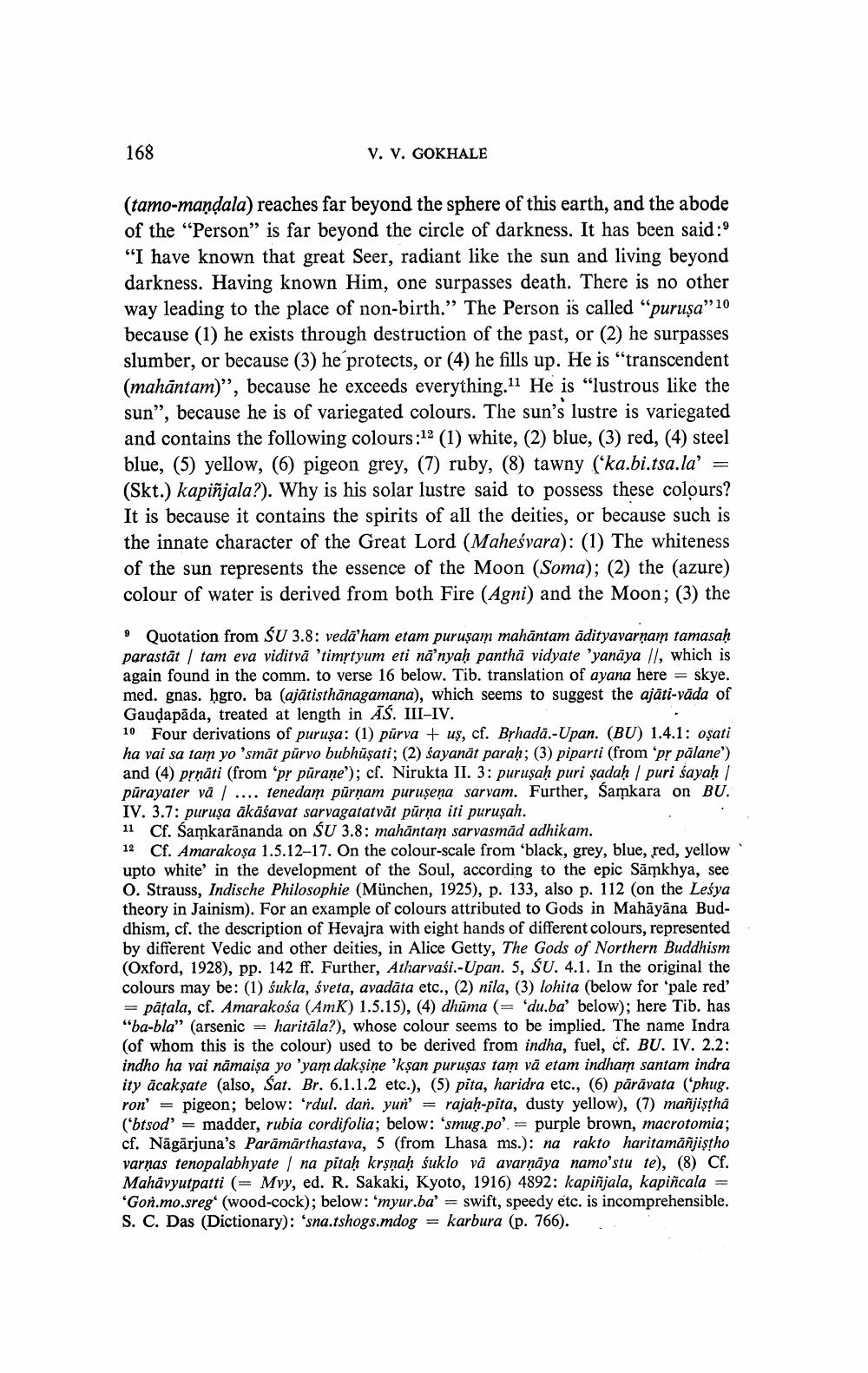Book Title: Vedanta Philosophy Described By Bhavya In His Madhyamaka Hrdaya Author(s): V V Gokhale Publisher: V V Gokhale View full book textPage 4
________________ 168 V. V. GOKHALE (tamo-mandala) reaches far beyond the sphere of this earth, and the abode of the “Person” is far beyond the circle of darkness. It has been said:9 "I have known that great Seer, radiant like the sun and living beyond darkness. Having known Him, one surpasses death. There is no other way leading to the place of non-birth.” The Person is called "purușa” 10 because (1) he exists through destruction of the past, or (2) he surpasses slumber, or because (3) he protects, or (4) he fills up. He is "transcendent (mahāntam)”, because he exceeds everything. 11 He is "lustrous like the sun”, because he is of variegated colours. The sun's lustre is variegated and contains the following colours :12 (1) white, (2) blue, (3) red, (4) steel blue, (5) yellow, (6) pigeon grey, (7) ruby, (8) tawny ("ka.bi.tsa.la' = (Skt.) kapiñjala?). Why is his solar lustre said to possess these colours? It is because it contains the spirits of all the deities, or because such is the innate character of the Great Lord (Maheśvara): (1) The whiteness of the sun represents the essence of the Moon (Soma); (2) the (azure) colour of water is derived from both Fire (Agni) and the Moon; (3) the 9 Quotation from SU 3.8: vedā' ham etam puruşam mahāntam adityavarnam tamasaḥ parastāt / tam eva viditvā 'timstyum eti na'nyaḥ pantha vidyate 'yanāya ll, which is again found in the comm. to verse 16 below. Tib. translation of ayana here = skye. med. gnas. hgro. ba (ajātisthānagamana), which seems to suggest the ajāti-vāda of Gaudapāda, treated at length in AS. III-IV. 10 Four derivations of puruşa: (1) pūrva + uş, cf. Byhadā.- Upan. (BU) 1.4.1: oșati ha vai sa tam yo 'smāt pūrvo bubhūșati; (2) sayanāt paraḥ; (3) piparti (from 'pr pālane") and (4) prnäti (from 'pr pürane'); cf. Nirukta II. 3: puruşah puri șadah / puri sayah / pūrayater vå) .... tenedam pürnam purusena sarvam. Further, Samkara on BU. IV. 3.7: puruşa ákāśavat sarvagatatvāt pūrņa iti puruṣah. 11 Cf. Samkarānanda on ŚU 3.8: mahāntam sarvasmad adhikam. 12 Cf. Amarakoşa 1.5.12–17. On the colour-scale from 'black, grey, blue, red, yellow upto white' in the development of the Soul, according to the epic Sāmkhya, see 0. Strauss, Indische Philosophie (München, 1925), p. 133, also p. 112 (on the Leśya theory in Jainism). For an example of colours attributed to Gods in Mahāyāna Buddhism, cf. the description of Hevajra with eight hands of different colours, represented by different Vedic and other deities, in Alice Getty, The Gods of Northern Buddhism (Oxford, 1928), pp. 142 ff. Further, Atharvasi.-Upan. 5, ŚU. 4.1. In the original the colours may be: (1) śukla, sveta, avadāta etc., (2) nila, (3) lohita (below for 'pale red' = pāțala, cf. Amarakośa (AmK) 1.5.15), (4) dhūma (= 'du.ba' below); here Tib. has "ba-bla" (arsenic = haritala?), whose colour seems to be implied. The name Indra (of whom this is the colour) used to be derived from indha, fuel, cf. BU. IV. 2.2: indho ha vai nāmaisa yo 'yam dakṣiṇe 'kşan puruṣas tam vă etam indham santam indra ity ācakşate (also, Sat. Br. 6.1.1.2 etc.), (5) pita, haridra etc., (6) pārāvata (phug. ron' = pigeon; below: 'rdul. dan. yun' = rajah-pita, dusty yellow), (7) mañjiştha ('htsod' = madder, rubia cordifolia; below: 'smug.po'. = purple brown, macrotomia; cf. Nāgārjuna's Parāmārthastava, 5 (from Lhasa ms.): na rakto haritamāñjiştho varņas tenopalabhyate na pitah krýnaḥ śuklo vā avarņāya namo'stu te), (8) Cf. Mahāvyutpatti (= Mvy, ed. R. Sakaki, Kyoto, 1916) 4892: kapiñjala, kapiñcala = 'Gon.mo.sreg' (wood-cock); below: 'myur.ba = swift, speedy etc. is incomprehensible. S. C. Das (Dictionary): 'sna.tshogs.mdog = karbura (p. 766). a, eta Atharvasi. Uply, The Gods of colours, repPage Navigation
1 2 3 4 5 6 7 8 9 10 11 12 13 14 15 16
